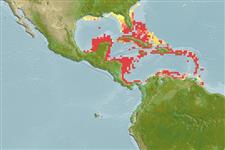Teleostei (teleosts) >
Perciformes/Serranoidei (Groupers) >
Serranidae (Sea basses: groupers and fairy basslets)
Etymology: Serranus: Latin, serran, serranus, saw and a fish of genus Serranus (Ref. 45335).
More on author: Bloch.
Environment: milieu / climate zone / depth range / distribution range
Ecology
Marine; reef-associated; depth range 0 - 40 m (Ref. 9710). Tropical; 33°N - 7°N, 96°W - 58°W
Western Atlantic: Bermuda and southern Florida, USA to northern South America; throughout the Caribbean (Ref. 13442). Including Antilles (Ref. 26938).
Size / Weight / Age
Maturity: Lm ? range ? - ? cm
Max length : 29.0 cm FL male/unsexed; (Ref. 6937)
Dorsal spines (total): 10; Dorsal soft rays (total): 12. Snout long and pointed. Black stripes and bars forming irregular rectangles on body. Has unique pointed snout and distinct color pattern make it easy to identify (Ref. 26938).
Most common in areas with rock or scattered coral. Solitary or in pairs. Feeds mainly upon crustaceans (Ref. 5521). Synchronously hermaphroditic. The most common member of the genus (Ref. 9710).
Life cycle and mating behavior
Maturity | Reproduction | Spawning | Eggs | Fecundity | Larvae
Displays facultative monogamy where males are constrained to mate with a single female due to resource limitation (Ref. 52884). Pelagic spawner (Ref. 32216).
Robins, C.R. and G.C. Ray, 1986. A field guide to Atlantic coast fishes of North America. Houghton Mifflin Company, Boston, U.S.A. 354 p. (Ref. 7251)
IUCN Red List Status (Ref. 130435: Version 2024-2)
Threat to humans
Harmless
Human uses
Fisheries: commercial; aquarium: commercial
Tools
Special reports
Download XML
Internet sources
Estimates based on models
Preferred temperature (Ref.
123201): 25.3 - 28.1, mean 27.1 °C (based on 138 cells).
Phylogenetic diversity index (Ref.
82804): PD
50 = 0.5000 [Uniqueness, from 0.5 = low to 2.0 = high].
Bayesian length-weight: a=0.01023 (0.00609 - 0.01719), b=3.04 (2.89 - 3.19), in cm total length, based on LWR estimates for this species & Genus-body shape (Ref.
93245).
Trophic level (Ref.
69278): 3.5 ±0.37 se; based on food items.
Resilience (Ref.
120179): Medium, minimum population doubling time 1.4 - 4.4 years (Preliminary K or Fecundity.).
Fishing Vulnerability (Ref.
59153): Low vulnerability (22 of 100).
Nutrients (Ref.
124155): Calcium = 50.5 [31.2, 89.5] mg/100g; Iron = 0.572 [0.316, 0.948] mg/100g; Protein = 18.4 [16.6, 20.0] %; Omega3 = 0.148 [0.100, 0.221] g/100g; Selenium = 28.3 [18.0, 49.0] μg/100g; VitaminA = 112 [41, 346] μg/100g; Zinc = 1.29 [0.90, 1.80] mg/100g (wet weight);
